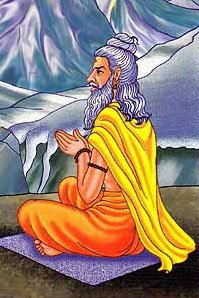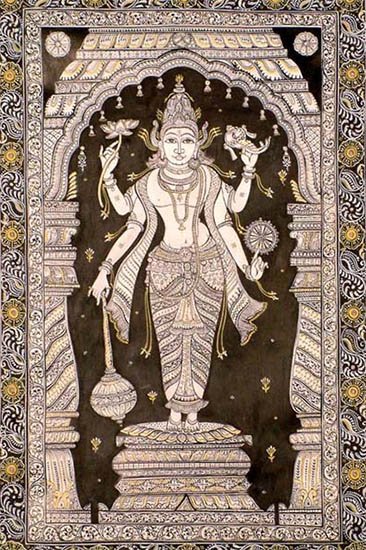Savyasaci, Savyasāci: 8 definitions
Introduction:
Savyasaci means something in Hinduism, Sanskrit, Marathi. If you want to know the exact meaning, history, etymology or English translation of this term then check out the descriptions on this page. Add your comment or reference to a book if you want to contribute to this summary article.
Alternative spellings of this word include Savyasachi.
In Hinduism
Purana and Itihasa (epic history)
Source: archive.org: Puranic EncyclopediaSavyasācī (सव्यसाची).—Another name of Arjuna. (Virāṭa Parva, Chapter 44, Verse 19).
Source: Cologne Digital Sanskrit Dictionaries: The Purana IndexSavyasāci (सव्यसाचि).—Arjuna, in the disguise of a hunter killed Mūka and three crores of Maṇivartana country;1 slew the Dānavas known as Paulomas and Kālakeyas.2
Source: JatLand: List of Mahabharata people and placesSavyasācī (सव्यसाची) is a name mentioned in the Mahābhārata (cf. VI.52.10, VIII.4.39, VIII.4.45) and represents one of the many proper names used for people and places. Note: The Mahābhārata (mentioning Savyasācī) is a Sanskrit epic poem consisting of 100,000 ślokas (metrical verses) and is over 2000 years old.

The Purana (पुराण, purāṇas) refers to Sanskrit literature preserving ancient India’s vast cultural history, including historical legends, religious ceremonies, various arts and sciences. The eighteen mahapuranas total over 400,000 shlokas (metrical couplets) and date to at least several centuries BCE.
Shilpashastra (iconography)
Source: Archaeological Survey of India: Śaiva monuments at Paṭṭadakal (śilpa)Savyasāci (सव्यसाचि) refers to a tile of Arjuna, and is found as a sculpture on the eighth pillar of the southern half of the maṇḍapa of the temple of Trailokyeśvara.—As Arjuna has the title of Savyasāci, “he who wields weapons with both hands”, he is shown with weapons in both of his hands. But the absence of tiara makes us to think how far our identification is valid. The battle between Arjuna and Indra’s adversaries is depicted in the upper panel.

Shilpashastra (शिल्पशास्त्र, śilpaśāstra) represents the ancient Indian science (shastra) of creative arts (shilpa) such as sculpture, iconography and painting. Closely related to Vastushastra (architecture), they often share the same literature.
General definition (in Hinduism)
Source: Wisdom Library: HinduismOne of the ten names assigned to Arjuna, the Hindu hero of the Mahabharata. Meaning of the name: "Skillful in using both arms, ambidextrous"
Source: WikiPedia: HinduismSavyasachi (सव्यसाचि): Ambidexter, one who can use both hands with equal facility and effect. A name of Arjuna who could use his bow with the same skill with either hands.
Languages of India and abroad
Marathi-English dictionary
Source: DDSA: The Molesworth Marathi and English Dictionarysavyasācī (सव्यसाची).—m (S) A name of Arjun from his being able to draw his bow as well with his left as with his right hand. Hence Applied to any person who can use both hands alike; an ambidexter.
Marathi is an Indo-European language having over 70 million native speakers people in (predominantly) Maharashtra India. Marathi, like many other Indo-Aryan languages, evolved from early forms of Prakrit, which itself is a subset of Sanskrit, one of the most ancient languages of the world.
Kannada-English dictionary
Source: Alar: Kannada-English corpusSavyasāci (ಸವ್ಯಸಾಚಿ):—
1) [noun] an archer who can use both the hands with the same ease.
2) [noun] a man who uses both the hands with the same ease.
3) [noun] a valorous man.
Kannada is a Dravidian language (as opposed to the Indo-European language family) mainly spoken in the southwestern region of India.
See also (Relevant definitions)
Starts with: Savyasacin, Savyasacisu.
Query error!
Relevant text
Search found 12 books and stories containing Savyasaci, Savyasāci, Savyasācī; (plurals include: Savyasacis, Savyasācis, Savyasācīs). You can also click to the full overview containing English textual excerpts. Below are direct links for the most relevant articles:
Bhagavad-gita (with Vaishnava commentaries) (by Narayana Gosvami)
Verse 11.33 < [Chapter 11 - Viśvarūpa-darśana-yoga (beholding the Lord’s Universal Form)]
Mahabharata (English) (by Kisari Mohan Ganguli)
Jnaneshwari (Bhavartha Dipika) (by Ramchandra Keshav Bhagwat)
Verse 18.11 < [Chapter 18 - Moksha-sannyasa-yoga]
Brahmanda Purana (by G.V. Tagare)
Chapter 6 - Glorification of The Race of Danu < [Section 3 - Upodghāta-pāda]
Chapter 5 - Nṛsiṃha incarnation and race of Hiraṇyakaśipu < [Section 3 - Upodghāta-pāda]
Puranic encyclopaedia (by Vettam Mani)
Chapter 11 - The Universal Form < [Chapter 1 - The Bhagavad-gita]